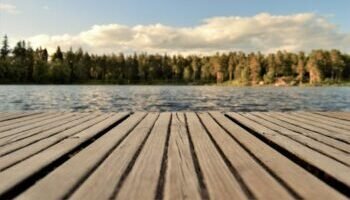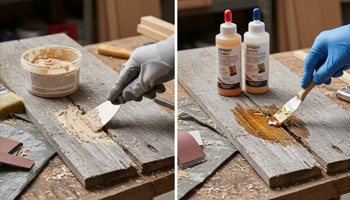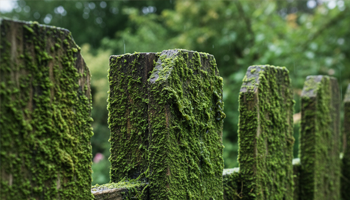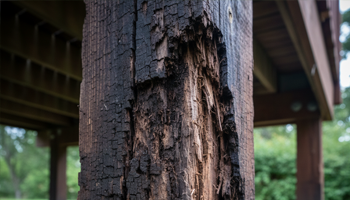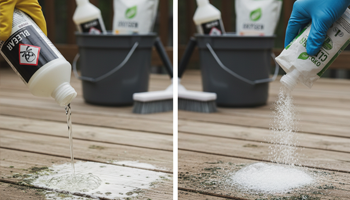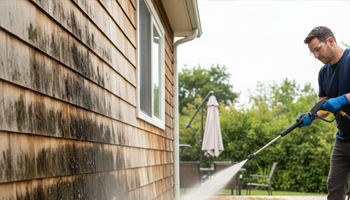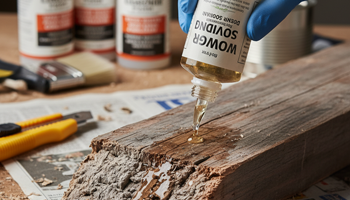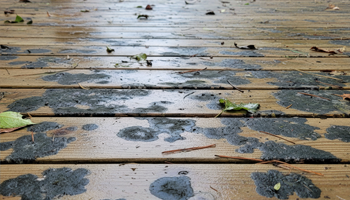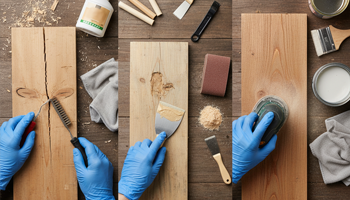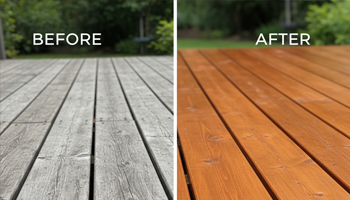Nail & Screw Staining on Wood
If you’re seeing blue-black halos around deck screws or rusty teardrops bleeding down siding, this guide will save you thousands. Staining from nails and screws isn’t “patina”—it’s a preventable failure that starts the day the wrong fastener touches the wrong wood in the presence of moisture. After two decades in the field, I’ve watched “deck screws” from big-box bins dissolve into warranty nightmares. Spend a little more on the correct fasteners now, or spend 10–15× later on tear-outs and re-finishing. Your choice.
“The term deck screws means nothing about corrosion resistance. I once bought ‘deck screws’ that were just thinly electroplated steel. On a cedar deck in rainy Portland, they created black stains everywhere within two seasons. I replaced 4,000+ screws—out of pocket.”
Understanding Metal-Wood Reactions: The Science Behind Staining
Iron-Tannin Chemical Reactions Explained
Most “black stains around deck screws” are not traditional rust; they’re iron-tannin complexes. Tannin-rich wood (cedar, redwood, oak, many tropicals) contains polyphenols that react instantly with iron in the presence of water and oxygen, forming ferric tannate—the blue-black compound outlining screw heads and nail holes. That’s why you can see “black rings around deck screws after sanding” after just one rain: sanding exposes bare metal, moisture completes the reaction, and the stain blooms.
Key takeaways:
- Speed: Reaction can appear within minutes after rainfall on new builds.
- Depth: Stain migrates into cell walls around the fastener, so surface-only cleaning doesn’t last if the iron source remains.
- “Not just rust”: Iron tannate forms even when fasteners look visually intact.
Galvanic Corrosion in Multi-Metal Systems
Mixing metals (e.g., galvanized hangers + stainless screws) in damp, tannic environments accelerates galvanic corrosion. The less noble metal sacrifices first (often the zinc coating), exposing steel that kick-starts iron-tannin staining. Add salt spray or coastal air and the process races ahead.
Why Tannin-Rich Woods Are Most Susceptible
Cedar, redwood, and oak are chemically primed for this failure. Many hardwoods (ipe, massaranduba, meranti) also carry tannins. Pressure-treated pine contains copper compounds that can attack unprotected steel and low-grade stainless, driving a different stain/rust pattern.
“I’ve seen ferric tannate halos appear during the first storm on new cedar fences fastened with cheap zinc-plated screws.”
Fastener-related staining prevention is covered in Wood Restoration Problems, and organic discoloration cleanup is explained in Remove Tannin Stains from Wood Siding & Decks.
Types of Fastener Staining: Identification Guide
Blue-Black Iron-Tannin Stains (Most Common)
- Look: Charcoal halos/rings around screw heads; smoky smudges below nails.
- Cause: Iron/tannin reaction (ferric tannate).
- Trigger: Any exposed steel, abraded galvanized coating, or ferrous dust.
Rust Bleeding from Corroded Fasteners
- Look: Orange-brown teardrops streaking down from fastener heads.
- Cause: Active corrosion (iron oxide) washing down grain lines.
- Often seen: Electroplated zinc screws in wet climates; old mild-steel nails.
Copper/Brass Verdigris Staining
- Look: Green/blue blush around hardware.
- Cause: Copper ions reacting with moisture, extractives, and finishes.
- Often seen: Copper nails or ACQ-treated lumber contacting incompatible metals.
Galvanized Coating Failure Patterns
- Look: Dull gray heads that later spot with black halos or rust freckles.
- Cause: Thin electroplated zinc gives up fast; hot-dipped lasts longer but still fails on high-tannin woods if sanded or scratched.
Wood Species Susceptibility: Risk Assessment
High-Risk Woods: Cedar, Redwood, Oak
- Naturally high tannin load.
- Rapid iron-tannate formation.
- Use 316 stainless only outdoors.
Moderate-Risk Woods: Douglas Fir, Mahogany
- Variable tannins and extractives.
- Stainless recommended near coastlines or constant wetting; 304 may suffice inland.
Low-Risk Woods: Pine, Spruce, Treated Lumber
- Lower tannin content, but chemical treatment (copper) can attack steel.
- Hot-dipped galvanized or 304 stainless work; avoid electroplated zinc.
Fastener Material Comparison: What Works and What Fails
Galvanized Steel: Lifespan and Failure Modes
- Electroplated: Paper-thin zinc. Cheap. Fails in 18–24 months on cedar/redwood.
- Hot-dipped (HDG): Thicker zinc; solid on PT pine. Still vulnerable if abraded or in salt spray/tannic woods.
Stainless Steel 304 vs. 316: When to Use Each
- 304: Good all-rounder for many decks and fences inland.
- 316: Molybdenum-alloyed; vastly better pitting resistance. Mandatory for cedar, redwood, oak, tropical hardwoods, and coastal exposure.
“For cedar/redwood/oak, I spec SS316 only. It’s worth every penny.”
Ceramic-Coated Screws Performance
- Protective ceramic over carbon steel. Better than zinc plating, worse than true stainless. If coating chips at the head, staining starts.
Hot-Dipped Galvanized vs. Electroplated
- HDG wins every time for treated pine and many structural connectors.
- Electroplated “construction” screws are not corrosion-resistant deck screws despite labeling.
Removing Existing Nail and Screw Stains
Oxalic Acid Treatment: The Only Effective Solution
For iron-tannin stains, oxalic acid is the gold-standard chelator. It dissolves ferric tannate and brightens grayed wood.
Application Techniques for Maximum Stain Removal
- Wet the surface uniformly.
- Apply oxalic solution (commonly 6–12%)—always follow manufacturer directions.
- Keep wet for dwell time; scrub lightly with a nylon brush.
- Rinse thoroughly; neutralize if required by your product.
- Allow to dry fully before refinishing.
Why Commercial Wood Brighteners Work
Most “wood brighteners” are oxalic or citric blends. They’re user-friendly, pre-measured, and add surfactants for even action.
Reoccurrence: When Stains Come Back After Treatment
If the iron source remains, staining returns in weeks to months. Cleaning is temporary. Permanent fix = replace the fasteners with stainless and refinish.
“Oxalic erases the marks… until the next wet cycle if the same iron screw head is still there.”
Structural Considerations: When Stains Indicate Bigger Problems
Fastener Integrity Assessment
Back out sample screws to inspect: red rust, necking, or thread loss means loss of capacity. Replace on the spot.
Wood Damage from Corrosion
Corrosion expands, crushing surrounding fibers and loosening grip. Look for spongy holes, split grain near stained areas.
When to Replace vs. Treat Fasteners
- Replace: Any electroplated zinc in exterior wood; any screw showing rust or coating loss; all mixed-metal combos near coast.
- Treat: Intact HDG in PT lumber inland with only superficial discoloration (and no structural role compromised).
Prevention During Installation: Best Practices
Fastener Selection Matrix by Wood Type
| Wood Type | Environment | Minimum Fastener | Best Practice |
|---|---|---|---|
| Cedar/Redwood/Oak | Any | 316 SS | 316 SS screws & nails; avoid coatings |
| Tropical Hardwoods (ipe, etc.) | Any | 316 SS | Pre-drill; 316 SS; hidden fasteners rated for hardwoods |
| PT Pine/Spruce | Inland | HDG | 304 SS preferred; ACQ-rated hardware |
| PT Pine/Spruce | Coastal | 304 SS | 316 SS where budget allows |
Pre-Drilling and Countersinking Strategies
Hardwoods and brittle species split around fasteners, exposing fresh tannins. Pre-drill and countersink to reduce fiber crush and finish failures.
Sealant Application Around Fastener Heads
A thin bead of high-quality exterior sealant under trim-head screws blocks water ingress and extractive bleed.
Avoiding Power Sanding Over Galvanized Fasteners
WARNING: Power sanding instantly removes protective zinc from galvanized heads. That bare steel becomes a staining factory after the next rain.
“I watched a contractor sand a $35K deck; by the weekend, every screw had a black halo. Insurance called it workmanship—not covered.”
Sealing and Coating Strategies
Primers That Prevent Bleed-Through
Use stain-blocking primers (shellac-based or specialty acrylics) before topcoats on tannin-heavy species and over fastener fields.
Caulking Fastener Holes: When and How
Countersink, vacuum dust, prime, then fill with epoxy or exterior-grade filler. Sand lightly and spot-prime before finish.
Paint vs. Stain Over Fasteners
- Solid paint hides best, especially over filled countersinks.
- Semi-transparent stains will telegraph any remaining discoloration—solve the fastener problem first.
Long-Term Maintenance: Inspection Schedule
Annual Assessment Techniques
- Randomly remove a few screws in wettest areas to check corrosion.
- Look for greenish or black halos (early warning on coatings).
- Test finish adhesion near fastener grids.
Early Warning Signs of Fastener Failure
- Creaks/loose boards at high-traffic zones.
- Orange streaks or blue-black rings spreading after storms.
- Powdery white corrosion at mixed-metal junctions.
Cost-Benefit Analysis: Cheap Fasteners vs. Premium
Real-World Lifespan Comparison (High-Tannin Woods)
| Fastener | Typical Lifespan* |
|---|---|
| Electroplated zinc “deck screws” | 18–24 months |
| Hot-Dipped Galvanized | 3–5 years |
| Stainless 304 | 10–15 years |
| Stainless 316 | 20+ years |
*Exposure, finish, and coastal factors vary.
Replacement Labor Costs
“Re-doing a deck because galvanized screws failed: $8,000–$15,000. The original upcharge for stainless: a few hundred dollars.”
When Premium Fasteners Pay Off
If stainless steel 304 vs 316 screws outdoor wood is your debate:
- Choose 316 for cedar/redwood/oak, hardwoods, and marine/coastal sites.
- Choose 304 for inland PT pine and moderate-risk woods.
- Use hot-dipped galvanized only where the wood and exposure justify it.
Sample material pricing (typical ranges):
- Galvanized deck screws: $8/lb
- SS304 deck screws: $22/lb
- SS316 deck screws: $35/lb
Timberarch Hardware Compatibility Guide
Recommended Fasteners for Timberarch Systems
For engineered members with modified tannin content, spec 316 stainless across the system—screws, bolts, washers, hangers, and hidden fasteners.
Installation Best Practices for Longevity
- Use one-metal systems (all 316 SS) to avoid galvanic couples.
- Isolate dissimilar metals with approved separators where unavoidable.
- Pre-drill dense members; torque to spec; verify head seating; spot-prime penetrations in painted assemblies.
Fastener Failure Timeline (High-Tannin Woods)
| Time After Install | What Fails First | What You See |
|---|---|---|
| 0–3 months | Sanded/abraded galvanized heads | “Blue-black” rings after first rain |
| 18–24 months | Electroplated zinc screws | Rust bleeding + black halos |
| 3–5 years | Hot-dipped galvanized in wet/coastal | Mixed rust/tannin staining; coating loss |
| 10–15 years | Stainless 304 in harsh exposure | Occasional tea staining at coast |
| 20+ years | Stainless 316 | Typically clean; finish aging only |
Decision Matrix: Wood Type → Fastener Recommendation
| Project Scenario | Best Screws | Why |
|---|---|---|
| New cedar deck (rainy climate) | 316 stainless | Stops iron-tannin stains at the source |
| Redwood siding (coastal) | 316 stainless | Pitting resistance; no green/black bleed |
| PT pine deck (inland) | 304 stainless (HDG acceptable) | Chemistry compatible; long service |
| Hardwood deck (ipe) | 316 stainless | Tannins + density demand top corrosion resistance |
| Fence on acreage (budget) | HDG with countersink + epoxy fill + paint | Acceptable if fully sealed; monitor closely |
Field-Tested Protocol That Always Works
- Choose fasteners by wood species + exposure (matrix above).
- Pre-drill and countersink; avoid abrading coatings.
- Spot-prime or seal around heads in finishing systems.
- If stains appear: oxalic acid now, replace iron-based fasteners soon.
- Schedule annual inspections to catch early warnings.
“Spend $200 more on the right screws at install, or $10,000+ on re-work later. It really is that simple.”
FAQs
How do I remove black stains around deck nails permanently?
Use oxalic acid to clear ferric tannate, then replace ferrous or damaged fasteners with 316 stainless. Otherwise the stains return.
Why do galvanized screws stain cedar wood?
Cedar’s tannins react with any exposed iron. Thin zinc plating wears or gets sanded off, exposing steel and causing iron-tannin stains.
What’s the best way to prevent screw stains on a new deck installation?
Select fasteners by species (prevent iron tannin stains new deck installation): 316 SS for cedar/redwood/hardwoods; 304 or HDG for PT pine inland. Don’t power-sand over heads.
Stainless steel 304 vs 316 screws for outdoor wood—when is 316 mandatory?
Use 316 for high-tannin woods, salt air, or constant wetting. Use 304 inland on lower-tannin woods and PT lumber.
What oxalic acid concentration should I use for iron-tannin stain removal?
Follow your product label; many pro mixes land around 6–12% for deck brightening. Rinse thoroughly and allow to dry before finishing.
Do ceramic-coated deck screws stop staining?
Better than zinc plating, but chips at the head can expose steel. For tannic species, 316 stainless is the reliable solution.
How long before galvanized screws rust in cedar?
Field reality: 18–24 months for electroplated zinc in wet climates; 3–5 years for HDG—faster near the coast.
⚠️ Critical Call-Outs
- Power sanding removes galvanized coating instantly → instant black halos after rain.
- “Deck screws” on the label ≠ corrosion-resistant → verify material (316/304, HDG, coating spec).
- Oxalic acid cleans, but stains WILL recur if iron remains → replace fasteners for permanence.
Currently viewing
Nail & Screw Staining on Wood
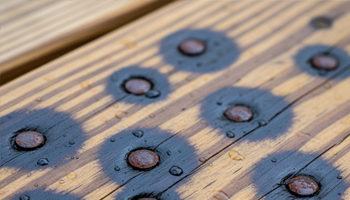
Material Longevity
Material Longevity in Coastal Urban Architecture Coastal construction confronts accelerated deterioration from salt spray, humidity…
Wood Filler for Exterior Repairs
Wood Filler vs Epoxy for Exterior Repairs: Weather Resistance Tested If you’re torn between “wood…
Green Algae on Wood Fence
Green Algae on Wood Fence Short version: Green algae on wooden fences is normal, fixable,…
Soft Rot in Deck Posts
Soft Rot in Deck Posts: Identification, Repair or Replace Decision Guide Safety First: This is…
Deck Mildew Remover
Deck Mildew Remover: Bleach vs Oxygen Cleaners If you’re hunting for the best deck mildew…
Stains on Wood Siding & Decks
How to Remove Tannin Stains from Wood Siding & Decks Short version: If you correctly…
Wood Rot Consolidants
Penetrating Epoxy vs PC Products In-Depth Review If you’re deciding between penetrating epoxies and off-the-shelf…
Black Mold on Deck
Black Mold on Deck: Safe Removal & Prevention Methods Safety First: Black mold and heavy…
Sources & Further Reading
External citations for further study and terminology alignment:

